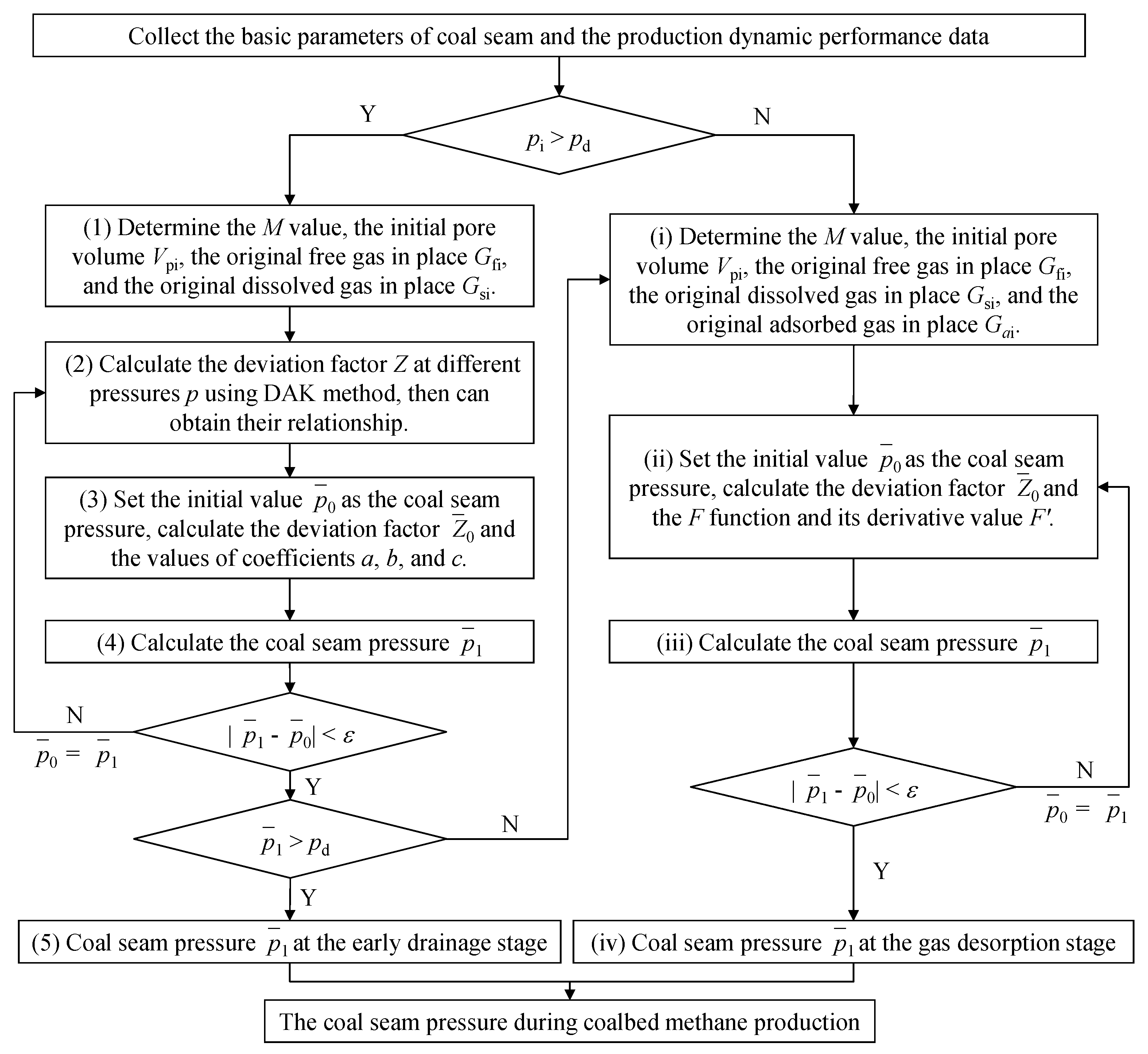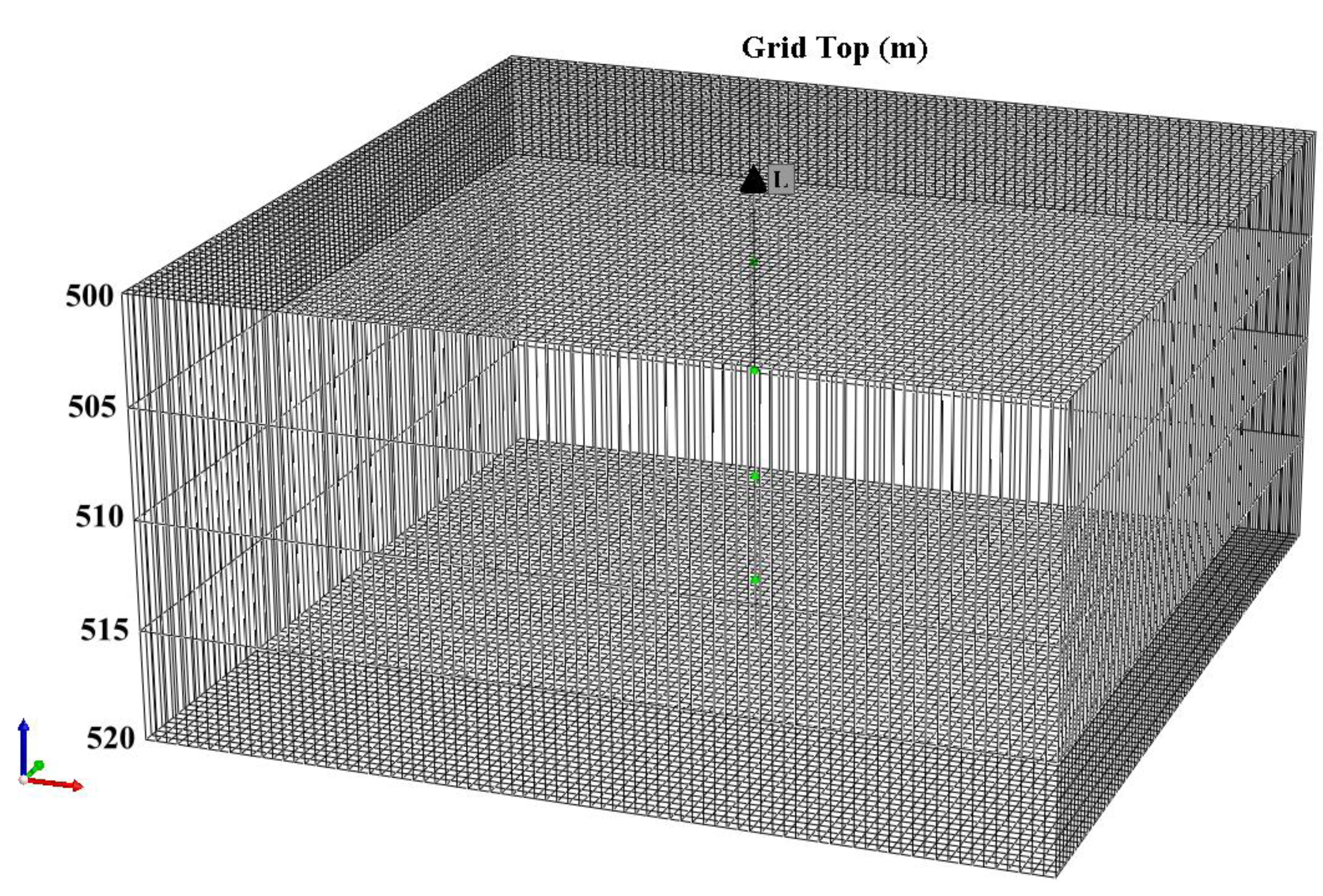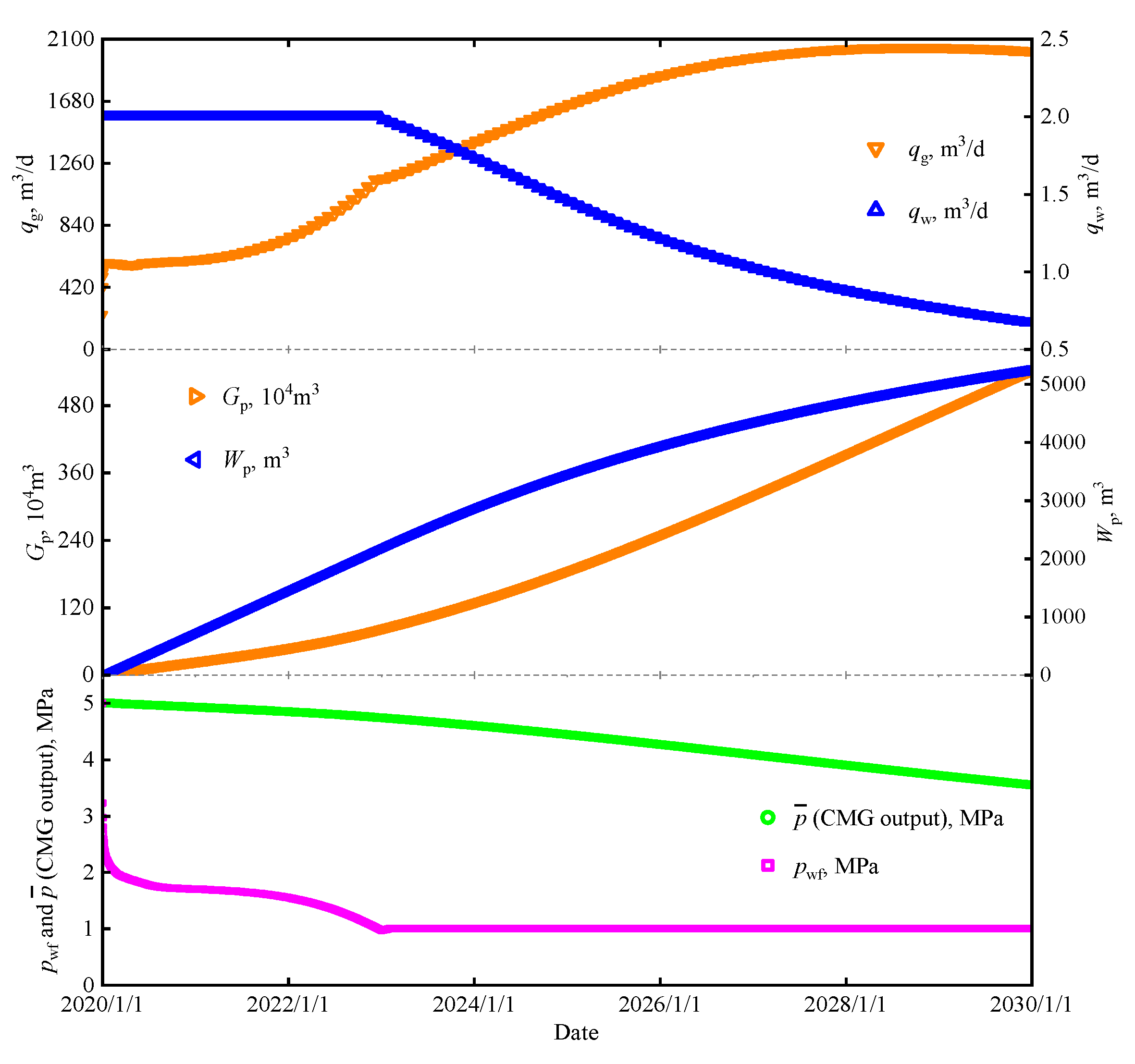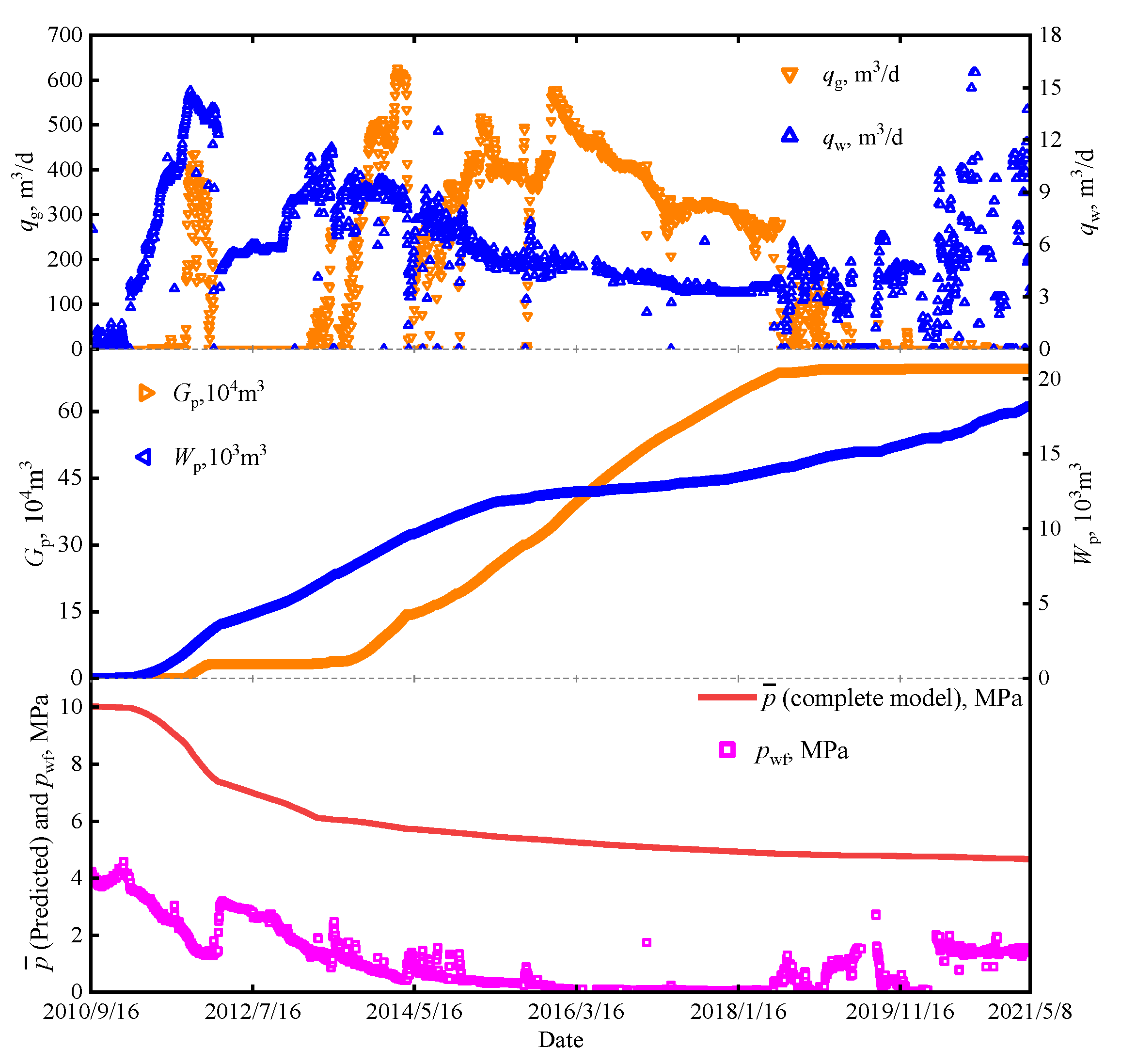An Analytical Method for Timely Predicting of Coal Seam Pressure during Gas Production for Undersaturated Coalbed Methane Reservoirs
Abstract
:1. Introduction
2. Model Establishment
2.1. Assumptions
- (1)
- The development process of undersaturated CBM reservoirs can be divided into an early drainage stage and gas desorption stage according to the critical desorption pressure; i.e., the influence of the critical desorption pressure is considered and two different models are established separately for these two stages.
- (2)
- The gas types include adsorbed gas, dissolved gas, and free gas in undersaturated CBM reservoirs. The special situation of the presence of free gas in undersaturated CBM reservoirs is also considered.
- (3)
- During the early drainage stage, the adsorbed gas cannot desorb, and the gas production occurs due to dissolved gas and free gas.
- (4)
- During the gas desorption stage, the produced gas is composed of adsorbed gas, dissolved gas, and free gas.
- (5)
- The desorption of the adsorbed gas is described by the Langmuir equation.
- (6)
- The dissolved gas in water conforms to Henry’s law.
- (7)
- The free gas conforms to the equation of state for real gas, i.e., the deviation factor Z is considered.
- (8)
- The stress sensitivity and matrix shrinkage effects on the porosity are considered.
- (9)
- The initial coal seam water expansion and water influx with decreasing coal seam pressure are considered.
- (10)
- The original gas in place remains constant during the whole production process.
2.2. Early Drainage Stage
2.3. Gas Desorption Stage
2.4. Calculation Procedures
- (1)
- Collect the basic parameters of coal seam and the cumulative water and gas productions of the coalbed methane wells and substitute them into Equations (5)–(8) to calculate the M value, the initial pore volume, the original free gas in place, and original dissolved gas in place.
- (2)
- (3)
- Set the initial value 0 as the coal seam pressure, calculate the initial value of the deviation factor 0 corresponding to the pressure, then calculate the values of the coefficients a, b, and c according to the basic parameters and cumulative production data in the statistical table.
- (4)
- Substitute the coefficients into Equation (10) to obtain the calculated value of the coal seam pressure 1.
- (5)
- Replace the initial value 0 with the calculated value 1 and repeat steps (3)–(5) until the error between the current calculated value and the previous calculated value is less than the desirable engineering tolerance, then the current calculated value will be the coal seam pressure at the early drainage stage. When the final coal seam pressure is less than the critical desorption pressure determined through drainage and production data or isothermal adsorption experiments, the early drainage stage ends and the gas desorption stage starts.
- (1)
- Substitute the basic parameters of coal seam and the cumulative water and gas productions of the coalbed methane well into Equations (5)–(8) and Equation (18) to calculate the M value, the initial pore volume, the original free gas in place, the original dissolved gas in place, and the original adsorbed gas in place.
- (2)
- Set the initial value 0 as the coal seam pressure, calculate the initial value of the deviation factor 0 under the pressure 0 according to the fitted polynomial relationship between the deviation factor and the pressure, and substitute the above parameters into Equations (20) and (21) to calculate the F function and its derivative value F’.
- (3)
- Substitute the required parameters into Equation (19) for Newton iteration to obtain the calculated value of the coal seam pressure 1.
- (4)
- Replace the initial value 0 with the calculated value 1, and repeat steps (2)–(4) until the error between the current calculated value and the previous calculated value is less than the desirable engineering tolerance, then the current calculated value will be the coal seam pressure in the gas desorption stage.
3. Validation
3.1. Validation through a Synthetic Simulation Case
3.2. Validation through Field Cases
3.2.1. Field Case I
3.2.2. Field Case II
4. Sensitivity Analyses
5. Discussion
6. Conclusions
Author Contributions
Funding
Data Availability Statement
Acknowledgments
Conflicts of Interest
References
- Xu, F.-Y.; Wang, B.; Zhao, X.; Yun, J.; Zhang, S.-Y.; Wang, H.-Y.; Yang, Y. Thoughts and suggestions on promoting high quality development of China’s CBM business under the goal of “double carbon”. China Pet. Explor. 2021, 26, 9–18. [Google Scholar]
- Zeng, Q.; Wang, Z. Stress and temperature sensitivity of coal permeability in the Eastern Ordos Basin. Pet. Sci. Bull. 2020, 4, 512–519. [Google Scholar]
- Shi, J.; Wu, J.; Fang, Y.; Lu, J.; Hou, C.; Li, X.; Zhang, S.; Xiong, X. A new coal seam permeability model considering the influence of pulverized coal blockage and its application. Nat. Gas Ind. 2020, 40, 78–89. [Google Scholar]
- Qin, Y.; Wu, J.; Zhang, Z.; Yi, T.; Yang, Z.; Jin, J.; Zhang, B. Analysis of geological conditions for coalbed methane co-production based on production characteristics in early stage of drainage. J. China Coal Soc. 2020, 45, 241–257. [Google Scholar]
- Mora, C.A.; Wattenbarger, R.A. Comparison of computation methods for CBM production performance. J. Can. Pet. Technol. 2009, 48, 42–48. [Google Scholar] [CrossRef]
- Clarkson, C.R.; Qanbari, F. A semi-analytical method for forecasting wells completed in low permeability, undersaturated CBM seams. J. Nat. Gas Sci. Eng. 2016, 30, 19–27. [Google Scholar] [CrossRef]
- Matteo, M.P.; Donald, L.; Dan, S.; Adrian, M. Advanced modeling of interwell-fracturing interference: An eagle ford shale-oil study. SPE J. 2016, 21, 1567–1582. [Google Scholar]
- Zhong, Z.; Wu, X.; Han, G. Pressure and saturation relationship in CBM seam and the semi-analytical production forecast model for the horizontal well. Pet. Sci. Bull. 2017, 2, 251–257. [Google Scholar]
- Shi, J.; Chang, Y.; Wu, S.; Xiong, X.; Liu, C.; Feng, K. Development of material balance equations for coalbed methane seams considering dewatering process, gas solubility, pore compressibility and matrix shrinkage. Int. J. Coal Geol. 2018, 195, 200–216. [Google Scholar] [CrossRef]
- Shi, J.; Jia, Y.; Wu, J.; Xu, F.; Sun, Z.; Liu, C.; Meng, Y.; Xiong, X.; Liu, C. Dynamic performance prediction of coalbed methane wells under the control of bottom-hole pressure and casing pressure. J. Pet. Sci. Eng. 2021, 196, 107799. [Google Scholar] [CrossRef]
- Shi, J.; Wu, J.; Sun, Z.; Xiao, Z.; Liu, C.; Sepehrnoori, K. Methods for simultaneously evaluating reserve and permeability of undersaturated coalbed methane seams using production data during the dewatering stage. Pet. Sci. 2020, 17, 1067–1086. [Google Scholar] [CrossRef]
- Mattar, L.; Mcneil, R. The “flowing” gas material balance. J. Can. Pet. Technol. 1998, 37, 52–55. [Google Scholar] [CrossRef]
- Mattar, L.; Anderson, D.; Stotts, G. Dynamic material balance-oil-or gas-in-place without shut-ins. J. Can. Pet. Technol. 2006, 45, 7–10. [Google Scholar] [CrossRef]
- Gonzalez, F.E.; Ilk, D.; Blasingame, T.A. A quadratic cumulative production model for the material balance of an abnormally pressured gas seam. In Proceedings of the SPE Western Regional and Pacific Section AAPG Joint Meeting 2008, SPE 114044, Bakersfield, CA, USA, 31 March–1 April 2008. [Google Scholar]
- Dusseault, M.B. Geomechanical challenges in petroleum reservoir exploitation. KSCE J. Civ. Eng. 2011, 15, 669–678. [Google Scholar] [CrossRef]
- Li, P.; Kong, X.; Lu, D. Calculating average gas seam pressure by integrating pseudo pressure distribution. Nat. Gas Ind. 2000, 20, 67–69. [Google Scholar]
- Zhang, L.; Wang, Y.; Ni, J.; Qiao, X.; Xin, C.; Zhang, T.; Kang, Y.; Shi, J.; Wu, K. A new method for tracking and calculating average formation pressure of gas seams. Acta Pet. Sin. 2021, 42, 492–499. [Google Scholar]
- Muskat, M. Use of data oil the build-up of bottom-hole pressures. Trans. AIME 1937, 123, 44–48. [Google Scholar] [CrossRef]
- Araps, J.J.; Smith, A.E. Practical use of bottom-hole pressure buildup curves. In Drilling and Production Practice; API: New York, NY, USA, 1949; pp. 155–165. [Google Scholar]
- Brons, F.; Miller, W.C. A simple method for correcting spot pressure readings. J. Pet. Technol. 1961, 13, 803–805. [Google Scholar] [CrossRef]
- Horner, D.R. Pressure build-up in wells. In Proceedings of the 3rd World Petroleum Congress, The Hague, The Netherlands, 28 May–6 June 1951; pp. 503–523. [Google Scholar]
- Matthews, C.S.; Brons, F.; Hazebroek, P. A method for determination of average pressure in a boundary seam. Trans. AIME 1954, 201, 182–191. [Google Scholar] [CrossRef]
- Kazemi, H. Determining average seam pressure from pressure buildup tests. Soc. Pet. Eng. J. 1974, 14, 55–62. [Google Scholar] [CrossRef]
- Miller, C.C.; Dyes, A.B.; Hutchinson, C.A. The estimation of permeability and seam pressure from bottom-hole pressure build-up characteristics. Trans. AIME 1950, 2, 91–104. [Google Scholar]
- Dietz, D.N. Determination of average seam pressure from build-up surveys. J. Pet. Technol. 1965, 17, 955–959. [Google Scholar] [CrossRef]
- Chen, Y. A method of determining seam pressure by match data of the type curve. Acta Pet. Sin. 1988, 9, 67–74. [Google Scholar]
- Lu, D.; Kong, X. By use of the integral of pressure distribution to calculate the average seam pressure. Acta Pet. Sin. 1993, 14, 81–91. [Google Scholar]
- Hu, J. A simple method for determining average formation pressure of oil and gas well by using MDH method. Pet. Geol. Oilfield Dev. Daqing 1995, 14, 39–42. [Google Scholar]
- Kambiz, R.; Abdolnabi, H.; Abdolhassan, R. A least squares approach to estimating the average seam pressure. Iran. J. Oil Gas Sci. Technol. 2013, 2, 22–32. [Google Scholar]
- Orozco, D.; Aguilera, R. Use of dynamic data and a new material-balance equation for estimating average seam pressure, original gas in place, and optimal well spacing in shale gas seams. SPE Seam Eval. Eng. 2018, 21, 1035–1044. [Google Scholar]
- Yin, H.; Wen, G.; Xing, C.; Fu, J.; Perapon, F. Average formation pressure calculation for the composite oil seam with multi-well system. Spec. Oil Gas Seams 2019, 26, 76–80. [Google Scholar]
- Huang, X.; Qi, Z.; Lei, D.; Li, J. Energy weighing method to calculate the average pressure of gas seam. J. Chongqing Univ. Sci. Technol. (Nat. Sci. Ed.) 2014, 16, 24–26. [Google Scholar]
- Hu, C.; Wang, F.; Ai, C. Calculation of average seam pore pressure based on surface displacement using image-to-image convolutional neural network model. Front. Earth Sci. 2021, 9, 712681. [Google Scholar] [CrossRef]
- Zhao, J.; Zhang, S. Study on pressure drop transmission law of coal bed methane drainage seam stratum. Coal Sci. Technol. 2012, 40, 65–68. [Google Scholar]
- Du, Y.; Wu, C.; Zou, M.; Wang, C.; Jiang, W.; Lei, B. Study on seam pressure transmission law during gas mining and drainage process of coal bed methane well. Coal Eng. 2011, 1, 87–89. [Google Scholar]
- Li, X.; Pu, Y.; Sun, C.; Ren, W.; Li, Y.; Zhang, Y.; Li, J.; Zang, J.; Hu, A.; Wen, S.; et al. Recognition of absorption/desorption theory in coalbed methane seam and shale gas seam. Acta Pet. Sin. 2014, 35, 1113–1129. [Google Scholar]
- Ge, J.; Bai, X.; Chen, L. Prediction of seam pressure changes during CBM exploitation. Seam Eval. Dev. 2014, 4, 62–65. [Google Scholar]
- Wang, L. Research on the pressure sensitivity for low permeability fractured coalbed methane seam. Miner. Explor. 2020, 11, 157–162. [Google Scholar]
- Zeng, Q.; Gao, Q.; Wang, Z. Experimental and modeling studies on high pressure methane adsorbed on coals. Pet. Sci. Bull. 2020, 01, 78–92. [Google Scholar]
- Su, X.; Zhang, L. Prediction of seam pressure for coalbed gas. Nat. Gas Ind. 2004, 24, 88–90. [Google Scholar]
- Saltelli, A.; Aleksankina, K.; Becker, W.; Fennell, P.; Ferretti, F.; Holst, N.; Li, S.; Wu, Q. Why so many published sensitivity analyses are false: A systematic review of sensitivity analysis practices. Environ. Model. Softw. 2019, 114, 29–39. [Google Scholar] [CrossRef]
- Yin, Z.; Feng, T.; MacBeth, C. Fast assimilation of frequently acquired 4D seismic data for reservoir history matching. Comput. Geosci. 2019, 128, 30–40. [Google Scholar] [CrossRef]
- Shin, M.-J.; Guillaume, J.H.A.; Croke, B.F.W.; Jakeman, A.J. Addressing ten questions about conceptual rainfall–runoff models with global sensitivity analyses in R. J. Hydrol. 2013, 503, 135–152. [Google Scholar] [CrossRef]
- Yin, Z.; Strebelle, S.; Caers, J. Automated Monte Carlo-based quantification and updating of geological uncertainty with borehole data (AutoBEL v1. 0). Geosci. Model Dev. 2020, 13, 651–672. [Google Scholar] [CrossRef]
- Da Veiga, S. Global sensitivity analysis with dependence measures. J. Stat. Comput. Simulat. 2015, 85, 1283–1305. [Google Scholar] [CrossRef]
- Shi, J.; Sun, Z.; Liu, C.; Lv, M.; Fang, J.; Jia, Y.; Wu, S.; Li, X. An analytical model for fast and accurate prediction of production performance of coalbed methane wells. Nat. Gas Ind. 2018, 38 (Suppl. S1), 43–49. [Google Scholar]
- Klins, M.A.; Bouchard, A.J.; Cable, C.L. A polynomial approach to the van Everdingen-Hurst dimensionless variables for water encroachment. SPE Reserv. Eng. 1988, 3, 320–326. [Google Scholar] [CrossRef]
- Carter, R.D.; Tracy, G.W. An improved method for calculating water influx. Trans. AIME 1960, 219, 415–417. [Google Scholar] [CrossRef]
- Schilthuis, R.J. Active oil and seam energy. Trans. AIME 1963, 118, 33–52. [Google Scholar] [CrossRef]
- Fetkovich, M.J.; Reese, D.E.; Whitson, C.H. Application of a general material balance for high-pressure gas seams. SPE J. 1998, 3, 3–13. [Google Scholar] [CrossRef]
- Yan, Z.; Shi, J.; Qin, F.; Hong, S.; Bai, M. A new method for calculating dynamic seam and water influx of water drive gas seams. China Offshore Oil Gas 2021, 33, 93–103. [Google Scholar]
- Shi, J.T.; Jia, Y.R.; Zhang, L.L.; Ji, C.J.; Li, G.F.; Xiong, X.Y.; Huang, H.X.; Li, X.F.; Zhang, S.A. The generalized method for estimating reserves of shale gas and coalbed methane reservoirs based on material balance equation. Pet. Sci. 2022, 19, 2867–2878. [Google Scholar] [CrossRef]
- Dranchuk, P.M.; Abou-Kassem, H. Calculation of Z Factors for natural gases using equations of state. J. Can. Pet. Technol. 1975, 14, 34–36. [Google Scholar] [CrossRef]
- Li, X.; Zhuang, X.; Gang, T.; Sui, X.; Xie, L. Comprehensive appraisal and selection for gas compressibility factor calculating model. Oil Drill. Prod. Technol. 2001, 2, 42–46. [Google Scholar]







| Parameters | CMG | Well A | Well B |
|---|---|---|---|
| Coal seam thickness h, m | 20 | 4 | 14.3 |
| Coal seam temperature T, K | 308.15 | 298.15 | 319.15 |
| Single well control area A, m2 | 160,000 | 66,052 | 282,743 |
| Initial coal seam pressure pi, MPa | 5 | 3 | 11 |
| Critical desorption pressure pd, MPa | 5 | 3 | 5 |
| Initial porosity ϕi, fraction | 0.04 | 0.03 | 0.05 |
| Initial water saturation Swi, fraction | 1 | 0.9 | 1 |
| Water volume factor Bw, m3/sm3 | 1 | 1 | 1 |
| Langmuir volume VL, m3/m3 | 20 | 15 | 15 |
| Langmuir pressure constant bL, MPa−1 | 0.3 | 0.71 | 0.33 |
| Gas specific gravity γg, dimensionless | 20.00 | 0.6 | 0.552 |
| Pore compressibility Cp, MPa−1 | 0.01 | 0.0109 | 0.01087 |
| Water compressibility Cw, MPa−1 | 0.000425 | 0.0004 | 0.000435 |
| Coal matrix shrinkage coefficient Ca, dimensionless | 0.01 | 0.015 | 0.015 |
| Methane dissolubility coefficient in water Cs, MPa−1 | 0 | 0.243 | 0.243 |
| Parameters | Value |
|---|---|
| Coal seam thickness h, m | 9.00 |
| Coal seam temperature T, K | 305.15 |
| Single well control area A, m2 | 90,000.00 |
| Initial coal seam pressure pi, MPa | 10.00 |
| Critical desorption pressure pd, MPa | 6.00 |
| Initial porosity ϕi, fraction | 0.05 |
| Initial gas saturation Sgi, fraction | 0.15 |
| Water volume factor Bw, m3/sm3 | 1.00 |
| Langmuir volume VL, m3/m3 | 20.20 |
| Langmuir pressure constant bL, MPa−1 | 0.42 |
| Gas specific gravity γg, dimensionless | 0.60 |
| Pore compressibility Cp, MPa−1 | 0.0109 |
| Water compressibility Cw, MPa−1 | 0.0004 |
| Coal matrix shrinkage coefficient Ca, dimensionless | 0.0150 |
| Methane dissolubility coefficient in water Cs, MPa−1 | 0.2600 |
| Parameters | Ranges |
|---|---|
| Pore compressibility Cp, MPa−1 | 0.0001~0.0109 |
| Water compressibility Cw, MPa−1 | 0.0001~0.0009 |
| Coal matrix shrinkage coefficient Ca, dimensionless | 0.0001~0.03 |
| Methane dissolubility coefficient in water Cs, MPa−1 | 0.0001~0.3933 |
| Initial gas saturation Sgi, fraction | 0~0.2 |
| Critical desorption pressure pd, MPa | 5~10 |
| Number | Influencing Factors | Sensitivity Indexes SIf |
|---|---|---|
| 1 | Critical desorption pressure pd | 0.793721 |
| 2 | Initial free gas saturation Sgi | 0.240604 |
| 3 | Pore compressibility Cp | 0.065200 |
| 4 | Methane dissolubility coefficient in water Cs | 0.038401 |
| 5 | Water compressibility Cw | 0.004533 |
| 6 | Coal matrix shrinkage coefficient Ca | 0.000332 |
Disclaimer/Publisher’s Note: The statements, opinions and data contained in all publications are solely those of the individual author(s) and contributor(s) and not of MDPI and/or the editor(s). MDPI and/or the editor(s) disclaim responsibility for any injury to people or property resulting from any ideas, methods, instructions or products referred to in the content. |
© 2024 by the authors. Licensee MDPI, Basel, Switzerland. This article is an open access article distributed under the terms and conditions of the Creative Commons Attribution (CC BY) license (https://creativecommons.org/licenses/by/4.0/).
Share and Cite
Jia, Y.; Shi, J.; Zhang, L.; Li, W.; He, Y.; Li, Y.; Cao, J.; Ji, C.; Huang, H. An Analytical Method for Timely Predicting of Coal Seam Pressure during Gas Production for Undersaturated Coalbed Methane Reservoirs. Processes 2024, 12, 777. https://doi.org/10.3390/pr12040777
Jia Y, Shi J, Zhang L, Li W, He Y, Li Y, Cao J, Ji C, Huang H. An Analytical Method for Timely Predicting of Coal Seam Pressure during Gas Production for Undersaturated Coalbed Methane Reservoirs. Processes. 2024; 12(4):777. https://doi.org/10.3390/pr12040777
Chicago/Turabian StyleJia, Yanran, Juntai Shi, Longlong Zhang, Wenbin Li, Yifan He, Yue Li, Jingtian Cao, Changjiang Ji, and Hongxing Huang. 2024. "An Analytical Method for Timely Predicting of Coal Seam Pressure during Gas Production for Undersaturated Coalbed Methane Reservoirs" Processes 12, no. 4: 777. https://doi.org/10.3390/pr12040777





